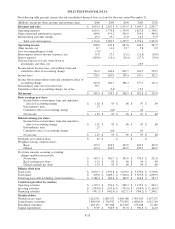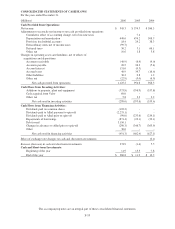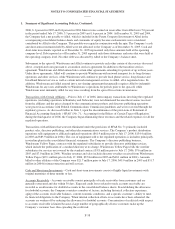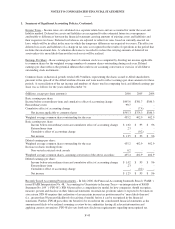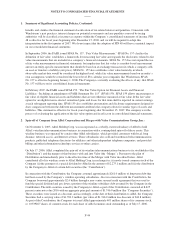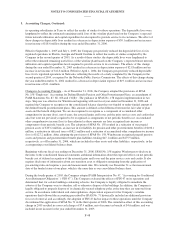Windstream 2006 Annual Report Download - page 139
Download and view the complete annual report
Please find page 139 of the 2006 Windstream annual report below. You can navigate through the pages in the report by either clicking on the pages listed below, or by using the keyword search tool below to find specific information within the annual report.
NOTES TO CONSOLIDATED FINANCIAL STATEMENTS
1. Summary of Significant Accounting Policies, Continued:
2006, 6.1 percent in 2005 and 6.8 percent in 2004. Interest rates earned on receivables from Alltel were 5.0 percent
in the period ended July 17, 2006, 3.5 percent in 2005 and 1.6 percent in 2004. At December 31, 2005 and 2004,
the Company had a net payable to Alltel, which is included in the Parent Company Investment of Alltel in the
accompanying consolidated balance sheets and statements of equity because such amounts were considered
contributed by Alltel to the Company. This payable was repaid in conjunction with the spin. The Company’s cash
and short-term investments held by Alltel were not allocated to the Company as of December 31, 2005. Cash and
short-term investments reported as of December 31, 2005 represented only those amounts held at the operating
company level. Debt reported as of December 31, 2005 reported only those debentures and notes that were held at
the operating company level. No other debt was allocated by Alltel to the Company’s balance sheet.
Subsequent to the spin-off, Windstream and Alltel continue to provide each other certain of the services discussed
above, at negotiated rates pursuant to a transition services agreement. In addition to the transition services
agreement, Windstream and Alltel entered into certain other agreements extending for periods of up to three years.
Under those agreements, Alltel will continue to provide Windstream with network transport for its long distance
operations and other services, while Windstream will continue to provide local phone service, long distance and
broadband Internet service as well as certain network management services to Alltel, all at negotiated rates. In
addition, Windstream and Alltel entered into a tax-sharing agreement that generally requires Alltel to indemnify
Windstream for any taxes attributable to Windstream’s operations for periods prior to the spin-off, while
Windstream must indemnify Alltel for any taxes resulting from the spin-off in certain circumstances.
Transactions with Certain Affiliates – Prior to July 17, of 2006, intercompany transactions involving the regulated
operations (excluding operations in Kentucky and Nebraska) were not eliminated because the revenues received
from the affiliates and the prices charged by the communications products and directory publishing operations
were priced in accordance with Federal Communications Commission guidelines and were recovered through the
regulatory process. As discussed further in Note 3, upon the discontinuance of the provisions of Statement of
Financial Accounting Standards (“SFAS”) No. 71, “Accounting for the Effects of Certain Types of Regulation,”
during the third quarter of 2006, the Company began eliminating these revenues and the related expenses for all the
regulated operations.
Transactions with affiliates that were not eliminated under the provisions of SFAS No. 71 primarily included
product sales, directory publishing, and other telecommunications services. The Company’s product distribution
operations sells equipment to affiliated regulated operations ($61.9 million prior to July 17, 2006, $134.4 million
in 2005 and $85.9 million in 2004). The cost of equipment sold to the regulated operations is included, principally,
in wireline plant in the consolidated financial statements. The Company’s directory publishing business,
Windstream Yellow Pages, contracts with the regulated subsidiaries to provide directory publishing services,
which include the publication of a standard directory at no charge. Windstream Yellow Pages bills the wireline
subsidiaries for services not covered by the standard contract ($3.8 million prior to July 17, 2006, $7.6 million in
2005 and $7.0 million in 2004). Wireline revenues and sales include directory royalties received from Windstream
Yellow Pages ($19.1 million prior to July 17, 2006, $35.8 million in 2005 and $40.1 million in 2004). Amounts
billed to other affiliates of the Company were $21.7 million prior to July 17, 2006, $45.0 million in 2005 and $51.7
million in 2004 for interconnection and toll services.
Cash and Short-term Investments – Cash and short-term investments consist of highly liquid investments with
original maturities of three months or less.
Accounts Receivable – Accounts receivable consist principally of trade receivables from customers and are
generally unsecured and due within 30 days. Expected credit losses related to trade accounts receivable are
recorded as an allowance for doubtful accounts in the consolidated balance sheets. In establishing the allowance
for doubtful accounts, the Company considers a number of factors, including historical collection experience,
aging of the accounts receivable balances, current economic conditions, and a specific customer’s ability to meet
its financial obligations to the Company. When internal collection efforts on accounts have been exhausted, the
accounts are written off by reducing the allowance for doubtful accounts. Concentration of credit risk with respect
to accounts receivable is limited because a large number of geographically diverse customers make up the
Company’s customer base, thus spreading the credit risk.
F-38


